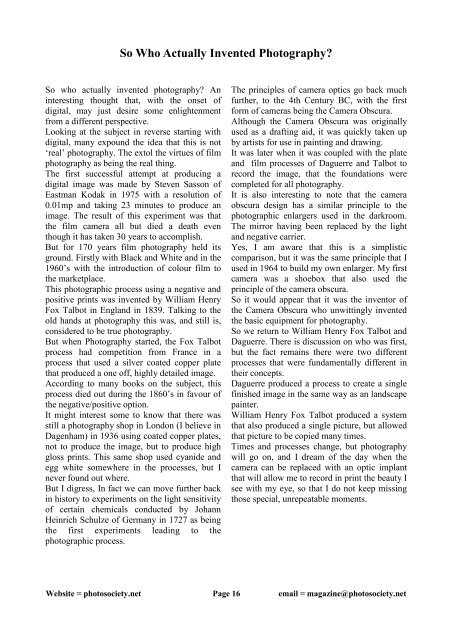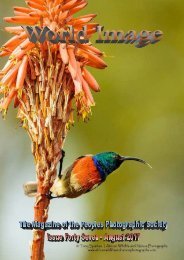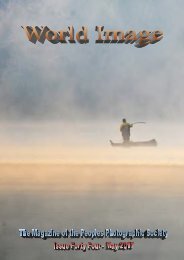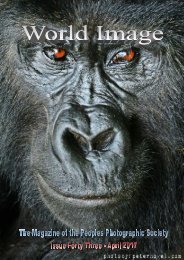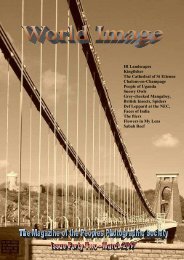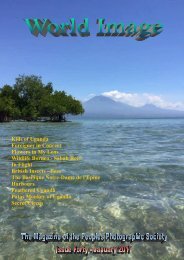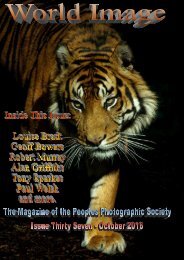World Image issue 11 October 2014
The Journal of the Peoples Photographic Society. Published on the 25th of each month, the latest edition is at: www.photosociety.net
The Journal of the Peoples Photographic Society. Published on the 25th of each month, the latest edition is at: www.photosociety.net
- No tags were found...
You also want an ePaper? Increase the reach of your titles
YUMPU automatically turns print PDFs into web optimized ePapers that Google loves.
So Who Actually Invented Photography?<br />
So who actually invented photography? An<br />
interesting thought that, with the onset of<br />
digital, may just desire some enlightenment<br />
from a different perspective.<br />
Looking at the subject in reverse starting with<br />
digital, many expound the idea that this is not<br />
‘real’ photography. The extol the virtues of film<br />
photography as being the real thing.<br />
The first successful attempt at producing a<br />
digital image was made by Steven Sasson of<br />
Eastman Kodak in 1975 with a resolution of<br />
0.01mp and taking 23 minutes to produce an<br />
image. The result of this experiment was that<br />
the film camera all but died a death even<br />
though it has taken 30 years to accomplish.<br />
But for 170 years film photography held its<br />
ground. Firstly with Black and White and in the<br />
1960’s with the introduction of colour film to<br />
the marketplace.<br />
This photographic process using a negative and<br />
positive prints was invented by William Henry<br />
Fox Talbot in England in 1839. Talking to the<br />
old hands at photography this was, and still is,<br />
considered to be true photography.<br />
But when Photography started, the Fox Talbot<br />
process had competition from France in a<br />
process that used a silver coated copper plate<br />
that produced a one off, highly detailed image.<br />
According to many books on the subject, this<br />
process died out during the 1860’s in favour of<br />
the negative/positive option.<br />
It might interest some to know that there was<br />
still a photography shop in London (I believe in<br />
Dagenham) in 1936 using coated copper plates,<br />
not to produce the image, but to produce high<br />
gloss prints. This same shop used cyanide and<br />
egg white somewhere in the processes, but I<br />
never found out where.<br />
But I digress, In fact we can move further back<br />
in history to experiments on the light sensitivity<br />
of certain chemicals conducted by Johann<br />
Heinrich Schulze of Germany in 1727 as being<br />
the first experiments leading to the<br />
photographic process.<br />
The principles of camera optics go back much<br />
further, to the 4th Century BC, with the first<br />
form of cameras being the Camera Obscura.<br />
Although the Camera Obscura was originally<br />
used as a drafting aid, it was quickly taken up<br />
by artists for use in painting and drawing.<br />
It was later when it was coupled with the plate<br />
and film processes of Daguerre and Talbot to<br />
record the image, that the foundations were<br />
completed for all photography.<br />
It is also interesting to note that the camera<br />
obscura design has a similar principle to the<br />
photographic enlargers used in the darkroom.<br />
The mirror having been replaced by the light<br />
and negative carrier.<br />
Yes, I am aware that this is a simplistic<br />
comparison, but it was the same principle that I<br />
used in 1964 to build my own enlarger. My first<br />
camera was a shoebox that also used the<br />
principle of the camera obscura.<br />
So it would appear that it was the inventor of<br />
the Camera Obscura who unwittingly invented<br />
the basic equipment for photography.<br />
So we return to William Henry Fox Talbot and<br />
Daguerre. There is discussion on who was first,<br />
but the fact remains there were two different<br />
processes that were fundamentally different in<br />
their concepts.<br />
Daguerre produced a process to create a single<br />
finished image in the same way as an landscape<br />
painter.<br />
William Henry Fox Talbot produced a system<br />
that also produced a single picture, but allowed<br />
that picture to be copied many times.<br />
Times and processes change, but photography<br />
will go on, and I dream of the day when the<br />
camera can be replaced with an optic implant<br />
that will allow me to record in print the beauty I<br />
see with my eye, so that I do not keep missing<br />
those special, unrepeatable moments.<br />
Website = photosociety.net Page 16 email = magazine@photosociety.net


